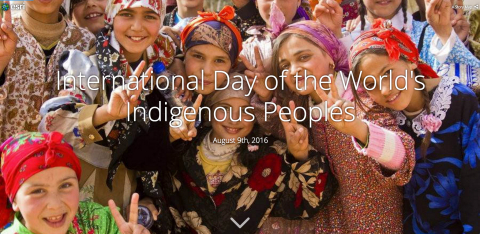Seven tribes create Tribal Story Maps using ArcGIS
REDLANDS, Calif. — (BUSINESS WIRE) — August 9, 2016 — The United Nations’ International Day of the World's Indigenous People is observed each year to promote and protect the rights of the world’s indigenous population. This year’s theme is right to education, and in honor of this, Esri partnered with seven tribes in a friendly competition to create Story Maps using the ArcGIS platform. The Story Maps bring attention to many different issues that affect tribal nations including climate change, forest resiliency and data sovereignty.
This Smart News Release features multimedia. View the full release here: http://www.businesswire.com/news/home/20160809005401/en/

The United Nations’ International Day of the World's Indigenous People is observed each year to promote and protect the rights of the world’s indigenous population. This year’s theme is right to education, and in honor of this, Esri partnered with seven tribes in a friendly competition to create Story Maps using the ArcGIS platform. (Photo: Business Wire)
Story Maps are a way to tap into and explore ideas. Through interactive maps, Confederated Tribes of Umatilla, Seneca National, Santa Clara Pueblo, Coeur d’Alene Tribe, Navajo, the Grand Ronde Tribe, and Sisseton Wahpeton Oyate (SWO) shared powerful narratives that educate viewers of the issues at hand.
Joseph Robertson, head of The Impact of Data Sovereignty on American Indian Self-Determination, created a story map discussing the impact of data sovereignty on American Indian self-determination. Robertson is pursuing his PhD at South Dakota State University and his dissertation is teaching tribal governments and stakeholders how to integrate not only GIS data systems, but fully centralized data systems using the Esri platform.
Robertson is changing his computational statistics PhD framework in real time to take advantage of the breakthrough GIS provides for a nation building by using the ArcGIS bridge with R. Now stakeholders can learn the basics of R for statistical learning and also use this approach for higher education. Esri’s technology will also teach tribes about the power of how a fully integrated GIS platform intersects the power of pure spatial statistics and analysis through theory and American Indian Law and Policy.
Regarding his implementation, Joseph Robertson said, “I am confident we can make an impact in showing Indigenous communities what is possible in a data driven world through the eyes of an Indigenous person with the skill set to make this possible.”
Explore the meaning of the International Day of the World’s Indigenous People using this Story Map. Learn more about how Esri helps create a sustainable world for all people, visit go.esri.com/pr-susdev.
About Esri
Since 1969, Esri has been giving customers around the world the power to think and plan geographically. The market leader in GIS technology, Esri software is used in more than 350,000 organizations worldwide including each of the 200 largest cities in the United States, most national governments, more than two-thirds of Fortune 500 companies, and more than 7,000 colleges and universities. Esri applications, running on more than one million desktops and thousands of web and enterprise servers, provide the backbone for the world's mapping and spatial analysis. Esri is the only vendor that provides complete technical solutions for desktop, mobile, server, and Internet platforms. Visit us at esri.com/news.
Copyright © 2016 Esri. All rights reserved. Esri, the Esri globe logo, GIS by Esri, esri.com, and @esri.com are trademarks, service marks, or registered marks of Esri in the United States, the European Community, or certain other jurisdictions. Other companies and products or services mentioned herein may be trademarks, service marks, or registered marks of their respective mark owners.
View source version on businesswire.com: http://www.businesswire.com/news/home/20160809005401/en/
Contact:
Esri
Karen Richardson
909-793-2853, extension 1-3491
Email
(press only):
Email Contact
General
Information:
Email Contact








